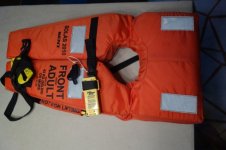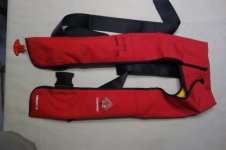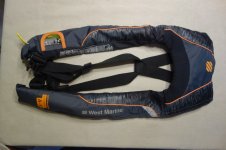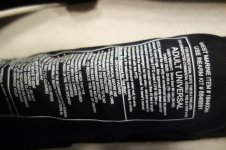Some of my (our) thoughts and considerations regarding PFD’s and C-Dorys.
For higher risk cruising, such as across the Gulf, exposed outside off the Everglades, the Great Lakes and the larger sounds, it makes a lot of sense to carry Type I Offshore PFD’s. SOLAS (Saftey of Life At Sea) is an international accrediting agency that promulgates stricter standards than the USCG does. So when we replace an Offshore Type I, it’s SOLAS approved. Additional features not found on other Type I include a ‘Buddy Line’ (so we’ll be found together, hopefully), better reflectives, loops for a Storm Whistle and a strobe light etc. Note our strobe lights are also SOLAS approved. SOLAS strobe lights show up very well for airbourne searches with night vision goggles.

The extra cost is minimal. However, they all take up a lot of room on a C-Dory, and we elect not to take them on a low-risk, protected waters voyage like our just completed Tenn-Tom adventure; we had ONLY two auto inflate PFD’s which ARE USCG Type II that do NOT have to be worn to satisfy the carriage requirements. West Marine Offshore Model 2042A. Always look for 35# buoyancy, some are as low as 22# and may not turn an unconscious person's head up and back to allow breathing.
We want an auto inflate feature in case we fall in unconscious.
The downside is that rain or even fog or mist can dissolve the aspirin-like ‘bobbin’ which is keeping the spring-loaded trigger from puncturing the CO2 canister and inflating the flotation jacket. Both bobbins and CO2 should be replaced at 3 years from mfg date, not your purchase date. The good news is that if the bobbin material falls apart, your PFD will pop open. Assuming the CO2 hasn’t leaked out.
A green stripe or window etc shows that the trigger portion is properly attached to the CO2 canister. It does NOT show whether the canister has any pressure. And you can always manually inflate it with a one-way tube by mouth. Re-arm kits run $30-40.
Pros can’t have their PFD’s popping off every time they work in the rain. The alternative trigger mechanism is a hydrostatic trigger that will only activate if submerged in four inches of water. And yes, they are more expensive. These are good for 5 years and re-arm kits run $75.
Federal law requires your PFD label to show the Type approval and whether the approval requires it to be worn. Here is a manual-only vest we use only for locking in the rain. USCG inspectors like it if the PFD is pre-fit for a crewmember and which one, which makes sense in an emergency.

Per the required label, Type V Approved Only When Worn.

This is the West Marine Offshore model we chose, because it was on a buy one get one 50% off and we like the return policy. I think Mustang is the premier brand for comfort, quality and not abandoning re-arm kits quickly. New models include a clear plastic window so inspectors can see whether or not the green Indicator is showing proper assembly. They are shipped WITHOUT the CO2 canister screwed in; don’t let the boarding party see that on your inflatable.

Per the required label, ‘For Recreational Boats: This is a Type II PFD’.
If it were Approved as a Type II PFD Only When Worn then this label would specify that.

If you Google ‘Are all inflatable PFD’S required to be worn to count?’ You’ll get the AI result, ‘ Yes, they are all Type V and must be worn to count’. So much for AI.
The online stores will not show you this, so before you buy, go in person to a West Marine and look carefully at the required label for the Type rating and whether required to be worn. Don’t ask the employees, they won’t have a clue.
I think Gold Loopers Tom and Joyce are correct that the USACE PFD locking requirements vary by district. The Tenn-Tom locks all required ‘The line handlers’ to wear one. Eileen handled her single line without ever leaving the safety of the cockpit. I also wore mine at the helm, though not required.
Hope something here is helpful as you and your crew decide on your own preferences and choices.
John





